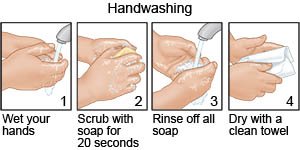How to Use A Nebulizer
Medically reviewed by Drugs.com. Last updated on Apr 6, 2025.
What is a nebulizer?
A nebulizer is a device that turns liquid medicine into a mist. As you breathe, the mist of medicine moves into your lungs. The nebulizer is usually connected to a machine that pushes air through the nebulizer. The air helps turn the medicine into a mist. When a nebulizer is used it is called a breathing treatment or nebulizer treatment.
 |
Why do I need breathing treatments?
Breathing treatments are used to treat the swelling of your airway, shortness of breath, coughing, and wheezing. These can be caused by any of the following:
- Chronic respiratory diseases, such as asthma and chronic obstructive pulmonary disease (COPD)
- Lung infections, such as pneumonia
- Severe allergic reactions
How do I use a nebulizer?
Read and follow the instructions that come with your nebulizer before use. The following is general information:
- Wash your hands with soap and water before you prepare the nebulizer for use. This helps prevent germs from getting into your lungs.

- Prepare the machine. Place the machine on a hard surface. Check to see if the air filter is clean. If it is dirty, rinse it using cold water and let it air dry. Plug in the machine.
- Prepare the medicine. If your medicine is premixed, open it and place it in the nebulizer medicine container. If you have to mix medicines, place the correct amounts into the container using a dropper or syringe.
- Add saline if needed. You may need to add saline (saltwater) to your medicine container. Buy sterile normal saline at a pharmacy. Do not use homemade saline solution in a nebulizer.
- Connect the container. Connect the medicine container to the machine using the tubing. Connect the mask or mouthpiece to the top of the container.
- Place the mouthpiece between your lips. Close your lips tightly around it. If you use a mask, place it over your mouth and nose. Make sure the mask fits snugly against your face.
- Turn on the machine. Keep the medicine container in an upright position. Breathe in and out slowly and deeply through your mouth until the mist is gone. The treatment is over when all the medicine is gone or there is no more mist coming out. The whole treatment may take up to 20 minutes. The machine may also make a sputtering noise when the treatment is done.
- Rinse your mouth with water or saline after each treatment. Do not swallow the water or saline. If you use a mask, wash your face after each treatment.
Drugs used to treat this and similar conditions
Paracetamol
Paracetamol (Panadol, Calpol, Alvedon) is a widely used over-the-counter painkiller and fever ...
Zyrtec
Zyrtec (cetirizine) is used to treat allergy symptoms such as sneezing, itching, watery eyes, or ...
Omvoh
Omvoh is used to treat moderate to severe ulcerative colitis or Crohn's disease in adults. This ...
Pulmozyme
Pulmozyme is used to improve lung function in people with cystic fibrosis. Learn about side ...
Flonase
Flonase (fluticasone nasal) is used to treat nasal congestion, sneezing, and runny nose caused by ...
Symbicort
Symbicort (budesonide and formoterol) is used to prevent bronchospasm in people with asthma or ...
Doxycycline
Doxycycline is a tetracycline antibiotic used to treat many different bacterial infections such as ...
Terbutaline
Terbutaline systemic is used for allergic asthma, asthma, acute, asthma, maintenance, premature labor
Cetirizine
Cetirizine treats cold or allergy symptoms such as sneezing, itching, watery eyes, or runny nose ...
How do I take care of my nebulizer?
- Clean your nebulizer after each use. Separate all pieces before cleaning. Do not clean the pieces in a sink. Use a dedicated clean bowl. Wash the container and mouthpiece or mask with dish soap and warm water. Shake off the extra water and let the parts air dry. Make sure all pieces are completely dry before storing them away.
- Disinfect your nebulizer as directed. Follow the disinfection instructions that come with your nebulizer.
Call your local emergency number (911 in the US), or have someone call if:
- You feel the muscles around your airway tighten.
- Your breathing gets worse after a treatment.
- Your chest suddenly feels tight after your treatment.
When should I seek immediate care?
- You cough up blood.
- You develop a rash or hives after a treatment.
- You have a fast heartbeat and feel dizzy.
When should I call my doctor?
- Your hands, arms, or legs shake after the treatment.
- You have a fever and sore mouth or throat.
- Your symptoms do not improve, even with treatment.
- You have questions or concerns about your condition or care.
Care Agreement
You have the right to help plan your care. Learn about your health condition and how it may be treated. Discuss treatment options with your healthcare providers to decide what care you want to receive. You always have the right to refuse treatment. The above information is an educational aid only. It is not intended as medical advice for individual conditions or treatments. Talk to your doctor, nurse or pharmacist before following any medical regimen to see if it is safe and effective for you.© Copyright Merative 2025 Information is for End User's use only and may not be sold, redistributed or otherwise used for commercial purposes.
Further information
Always consult your healthcare provider to ensure the information displayed on this page applies to your personal circumstances.
